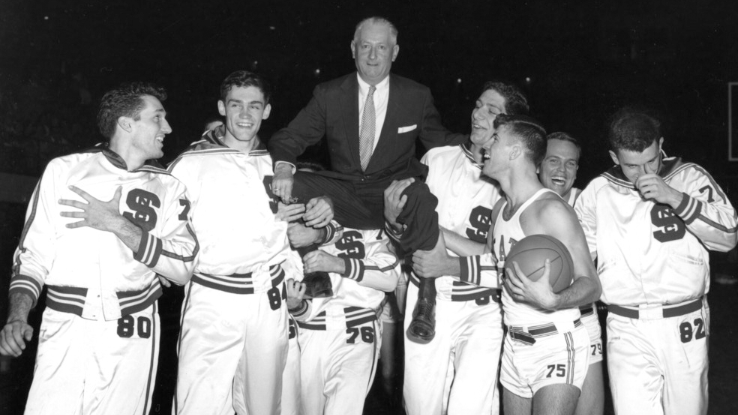
he NC State men’s basketball team lifts coach Everett Case on their shoulders after winning 1955 Atlantic Coast Conference championship.

he NC State men’s basketball team lifts coach Everett Case on their shoulders after winning 1955 Atlantic Coast Conference championship.
If, in the throes of March Madness, you are watching the series “The Tournament: A History of ACC Men’s Basketball,” perhaps you’ve wondered where the show got such great, historical photographs of NC State coach Everett Case and video footage of heart-stopping Wolfpack games through the years.
They came to the Libraries’ Special Collections Research Center (SCRC).
“The Tournament” is a ten-episode ESPN Films series that details the history of the 68-year-old ACC tournament. The series initially ran in February on the ACC Network before being carried on Disney platforms such as ABC, ESPN2, and ESPNU.
Co-produced by former Wolfpack guard Dereck Whittenburg, and sharing the executive producer team responsible for an ESPN documentary about NC State’s 1983 NCAA championship run, “The Tournament” highlights NC State's role in the tournament’s creation in its first two episodes and celebrates the legendary 1974 and 1983 teams in later episodes. The show also highlights the Libraries’ robust collections and celebrates the SCRC’s above-and-beyond digitization efforts.
The ESPN-SCRC working relationship started innocuously enough—with an email two years ago from Matt Fisher, the series’ archival producer, to the Center’s public mailbox asking for help.
“He was looking for photos and especially video of tournament games,” says Cathy Dorin-Black, University Archives Specialist at the SCRC. “One part of that was great, and pretty easy, because we have so many great images digitized already. We have our Rare and Unique Digital Collections site where [Digital Program Librarian for Special Collections] Brian Dietz has run our digital program and has a lot of great images already digitized.”
The SCRC team, which included Dorin-Black, Dietz, and University Library Technician Clara Wilson, helped Fisher find a wealth of photographs of coach Case and his Wolfpack cagers. Case came up with the idea for the tournament after having come to Raleigh from the Indiana high school ranks, where postseason tournaments had become nearly religious experiences for basketball fans.
After the ACC was formed in 1953 when NC State, UNC-Chapel Hill, Duke, Wake Forest, and other schools left the Southern Conference, Case advocated for Reynolds Coliseum to host a season-ending tournament that would give its winner an automatic berth in the NCAA tournament that determines the national championship. Most other conferences simply sent their first-place team at the end of the regular season. But Case saw a way to give the nascent ACC an immediate profile and fan base.
Boy, did Case’s vision work. Reynolds hosted the first 13 ACC tournaments, and the conference has never looked back. The first two episodes of the series narrate the tournament’s origin and early years in great detail and with exciting imagery—which presented an interesting challenge for the SCRC.
“As a start, [Fisher] was able to find a lot of great images to use for the documentary there,” says Dorin-Black. “It got a little trickier when he was interested in video, because a lot of that was actually on film.”
Enter Skip Elshiemer—aka A/V Geeks—the Raleigh-based master of small-gauge film. The NC State community is likely familiar with Elshiemer for his massive collection of vintage instructional and industrial films, and the Libraries event series “A/V Geeks at the Hunt Library” in which he screens and discusses them before a live audience. But people might not know that Elshiemer also restores old film and reformats it into digital video.
“There’s a whole process and workflow for that,” Dorin-Black says, “determining if it’s safe to get the film reformatted, seeing if it’s in a good enough condition and so forth. We owe a lot to Skip for this project. He does all of that reformatting work for us—and he does amazing work because it looks so clear.”
Fisher would scour the SCRC collection guide and tell Dorin-Black what reels he was interested in. Then the SCRC would determine if the reels could withstand the reformatting process and advise Fisher on the necessary copyright issues. Finally, the film went to Elshiemer, who returned digital files so that Fisher could work the footage into the documentary the way he needed to.
“It’s been really interesting to me to watch the first few episodes so far to see how they’re using the film,” Dorin-Black says. “They’ve connected it to the interviews of some of the players from back then and, as the players are recalling particular plays, they’re actually able to hone in on that play in the film. It’s really cool that instead of just having someone talk about their memory of a key moment in a game, they can actually have the film play along with it.”
Fisher mostly requested materials dating to the 1950s and 1960s, but Libraries materials dating to more recent teams found their way into “The Tournament” as well. The series’ fourth episode takes a deep dive into the 1974 tourney and “the greatest game ever played”—then #1-ranked NC State’s 103-100 overtime victory over Maryland in the tournament’s title game—and the sixth episode features the Jim Valvano-coached 1983 Cinderella team that won the NCAA title in cardiac fashion.
Dorin-Black and her colleagues—including University Archivist Todd Kosmerick, who was the main force in obtaining these materials—find a lot of satisfaction in having helped guide some previously inaccessible collections materials into such a high-profile project.
“I was actually part of the team that accessioned these materials, which is the process where Athletics calls us up and asks ‘Hey, do you all want this for the archives?’ So it’s amazing to have been part of the whole cycle from where these films were stored in a closet over in one of the Athletics buildings, to us getting them here, and then getting them available to this one producer, and now who knows how many people have seen them. It’s been really cool.”